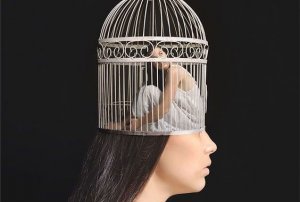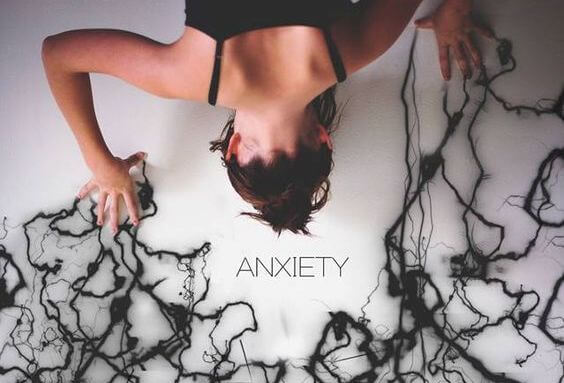The Most Common Types of Anxiety: From Social Anxiety to OCD

Anxiety is one of the greatest evils of our time. In fact now there are multiple types of anxiety identified and new classifications are continually being made. It’s no wonder, really, if you think about how demanding and fast our world is today. That equilibrium, both with yourself and others, is dynamic.
Anxiety is one of the many faces of fear. But unlike fear itself, in this case there is no specific stimulus triggering it. Fear is normal when you’re facing a specific threat and perceive that you’re in danger. However, anxiety is a form of fear that many times doesn’t have a definite cause. Thus, it’s not easy to find the origin or what is making it recur.
You know it’s anxiety because you feel uneasy, insecure, or preoccupied about “something,” however imprecise. You may feel like you’re on an airplane, free-falling, when you’re actually just sitting in your living room at home. Perhaps you feel an inner tingling that won’t leave you alone. Then, it makes you agitated and irritated. Yet, you can’t seem to identify the cause.
There are many different types of common anxiety. Some people prefer to simply call it “stress” or “worry”. But if you take a detailed look at it, it may be one of the more serious types of anxiety. The good thing is that each one of these types of anxiety can be treated. To start, let’s learn more about them.
Two common types of anxiety: generalized anxiety and social anxiety
Generalized anxiety disorder is defined as a state of constant worrying, for no apparent reason. It must have a duration of at least 6 months. And generally it’s accompanied by difficulty sleeping, irritability, problems concentrating and general fatigue.

Social anxiety, in turn, is a condition in which the person experiences fear or gets upset when they have to interact with others. In essence, people with these types of anxiety are afraid of being in contact with other people. Interestingly, a big part of these types of anxiety is anticipatory. That is, it happens before the feared social contact takes place.
Both conditions significantly affect the person’s quality of life. In addition, they do not just get better on their own over time. These types of anxiety tend to feed off of avoidance behaviors, too. And let’s remember, you’re not just going through a hard time; you have a condition that needs treatment.
In most cases, therapy for a short period of time is all it takes to regain control of one’s emotions. Other times, more time is required. Regardless, the probability of overcoming these conditions is very high.
Obsessive compulsive disorder and post-traumatic stress disorder
OCD is characterized by having persistent and intrusive thoughts that trigger fear and anxiety. No matter how much the individual tries to get the idea out of their head, they can’t. The obsessions may invade the individual’s personality and greatly affect their life.

PTSD, on the other hand, happens after having gone through a traumatic experience. It manifests as restlessness, difficulty sleeping and, above all, the recurring fantasy of the trauma happening again. Therefore the person is always on high alert. They feed their insecurity and isolation.
In both cases, depending on the severity of the symptoms, there are different ways to deal with the problem. Using relaxation techniques can significantly reduce a person’s anxiety. It can also enhance one’s ability to concentrate. If these methods fail, professional therapy is an excellent choice and often very successful.
Agoraphobia and hypochondria
Agoraphobia is now one of the most common types of anxiety. It is a vague, uncertain fear of any situation that seems to have no escape route. In other words, they fear situations that will trap them and prevent them from getting help if they have a panic attack.
In a way, it’s sort of like being afraid of fear itself. Every day, there are people seeking help for agoraphobia and the number is growing. People with agoraphobia truly suffer and have trouble living a normal life.

Something similar happens with hypochondriacs, who interpret every sign their body gives them as being the worst case scenario. They worry they have a serious illness and their condition might worsen at any moment. Also, they feel like they can’t do anything about it.
In either case, relaxation techniques are highly recommended. They help reduce or deactivate anxiety and keep it from escalating. They also teach a person how to read the signs their body sends them and make them feel like they have more self-control. Regular physical exercise is helpful as well. And as always, for all types of anxiety, it is a good idea to see a therapist.
Anxiety is one of the greatest evils of our time. In fact now there are multiple types of anxiety identified and new classifications are continually being made. It’s no wonder, really, if you think about how demanding and fast our world is today. That equilibrium, both with yourself and others, is dynamic.
Anxiety is one of the many faces of fear. But unlike fear itself, in this case there is no specific stimulus triggering it. Fear is normal when you’re facing a specific threat and perceive that you’re in danger. However, anxiety is a form of fear that many times doesn’t have a definite cause. Thus, it’s not easy to find the origin or what is making it recur.
You know it’s anxiety because you feel uneasy, insecure, or preoccupied about “something,” however imprecise. You may feel like you’re on an airplane, free-falling, when you’re actually just sitting in your living room at home. Perhaps you feel an inner tingling that won’t leave you alone. Then, it makes you agitated and irritated. Yet, you can’t seem to identify the cause.
There are many different types of common anxiety. Some people prefer to simply call it “stress” or “worry”. But if you take a detailed look at it, it may be one of the more serious types of anxiety. The good thing is that each one of these types of anxiety can be treated. To start, let’s learn more about them.
Two common types of anxiety: generalized anxiety and social anxiety
Generalized anxiety disorder is defined as a state of constant worrying, for no apparent reason. It must have a duration of at least 6 months. And generally it’s accompanied by difficulty sleeping, irritability, problems concentrating and general fatigue.

Social anxiety, in turn, is a condition in which the person experiences fear or gets upset when they have to interact with others. In essence, people with these types of anxiety are afraid of being in contact with other people. Interestingly, a big part of these types of anxiety is anticipatory. That is, it happens before the feared social contact takes place.
Both conditions significantly affect the person’s quality of life. In addition, they do not just get better on their own over time. These types of anxiety tend to feed off of avoidance behaviors, too. And let’s remember, you’re not just going through a hard time; you have a condition that needs treatment.
In most cases, therapy for a short period of time is all it takes to regain control of one’s emotions. Other times, more time is required. Regardless, the probability of overcoming these conditions is very high.
Obsessive compulsive disorder and post-traumatic stress disorder
OCD is characterized by having persistent and intrusive thoughts that trigger fear and anxiety. No matter how much the individual tries to get the idea out of their head, they can’t. The obsessions may invade the individual’s personality and greatly affect their life.

PTSD, on the other hand, happens after having gone through a traumatic experience. It manifests as restlessness, difficulty sleeping and, above all, the recurring fantasy of the trauma happening again. Therefore the person is always on high alert. They feed their insecurity and isolation.
In both cases, depending on the severity of the symptoms, there are different ways to deal with the problem. Using relaxation techniques can significantly reduce a person’s anxiety. It can also enhance one’s ability to concentrate. If these methods fail, professional therapy is an excellent choice and often very successful.
Agoraphobia and hypochondria
Agoraphobia is now one of the most common types of anxiety. It is a vague, uncertain fear of any situation that seems to have no escape route. In other words, they fear situations that will trap them and prevent them from getting help if they have a panic attack.
In a way, it’s sort of like being afraid of fear itself. Every day, there are people seeking help for agoraphobia and the number is growing. People with agoraphobia truly suffer and have trouble living a normal life.

Something similar happens with hypochondriacs, who interpret every sign their body gives them as being the worst case scenario. They worry they have a serious illness and their condition might worsen at any moment. Also, they feel like they can’t do anything about it.
In either case, relaxation techniques are highly recommended. They help reduce or deactivate anxiety and keep it from escalating. They also teach a person how to read the signs their body sends them and make them feel like they have more self-control. Regular physical exercise is helpful as well. And as always, for all types of anxiety, it is a good idea to see a therapist.
This text is provided for informational purposes only and does not replace consultation with a professional. If in doubt, consult your specialist.







